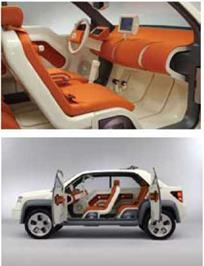Also known as eco-effectiveness, Cradle to Cradle, or C2C, is a popular framework that demands significant change, for good reason, but represents a high bar to reach for most organizations (see Figure 3.2). It is a powerful perspective on the cyclic nature of waste and food, as well as the need to keep technical and biological materials separated. Great strides have been made under the C2C framework, but it takes commitment and support from the highest levels of an organization to achieve. A new, accompanying certification includes more detailed criteria.
|
|
|
|
|


Elimination of Waste (everything is recycled or upcyded)
Strengths: Business-relevant and friendly. Integrates well with design and business functions. Easy to address in the development process. Easily combined with other frameworks.
Weaknesses: Doesn’t cover financial or social issues. Doesn’t propose metrics. Doesn’t describe a development process. Not deeply detailed. Doesn’t favor natural or organic materials and can be biased toward technological solutions. Doesn’t explicitly value local production, transportation, product life span, or embodied energy of components.
Another popular framework for understanding sustainability was proposed by Walter Stahel in the 1970s and made popular by William McDonough and Michael Braungart in their 2002 book, Cradle to Cradle. These two (one an architect, the other a materials engineer) have built solutions that have surprised and amazed their clients, industries, and the public. For example, they specialize in redesigning the manufacturing process and focusing on materials and process selection in order to sharply reduce toxicity (or eliminate it altogether) throughout the life cycle of products, but particularly in manufacturing. These solutions often result in factories that emit cleaner water after manufacturing than what was used to begin with.
Think about that for a moment. Imagine a factory whose outputs are cleaner than its inputs. That’s more than merely a factory—it’s now a system for cleaning and restoring the water or air or other aspects of the environment. Think about how that one alteration could change everything we expect about a factory. That’s what McDonough and Braungart excel at.
The basis for the Cradle to Cradle (C2C) approach involves four principles:
• Elimination of hazardous (toxic) materials
• “Waste equals food” (changing our definition of “waste”)
• Use the current solar income of energy
• Use “upcyclable” materials
The Cradle to Cradle framework (also known as eco-effectiveness to differentiate it from frameworks that focus on efficiency) requires us to question all materials and eliminate (or at least drastically reduce) all toxic materials. This framework has little tolerance for materials that harm customers, employees, workers, or the environment. Braungart and McDonough have found that a thorough examination of manufacturing materials and processes reveals no need for many of the toxic chemicals that are assumed necessary, out of habit or legacy. For example, industry malaise, assumptions, and lack of innovation in the carpet business fed the use of several toxic materials and processes until Interface hired Braungart and McDonough to examine their business. These consultants found that they could recommend the elimination of many assumed “necessary” chemicals with little or no impact on the manufacturing process and the elimination of many others with changes in some processes. The result is far fewer toxic materials used in the manufacturing process, and a product that can be recycled with even fewer toxic chemicals used in the recycling process.
The Cradle to Cradle framework, like many others, acknowledges the need to address the entire life cycle of production, transportation, use, and disposal, as well as the need to foster diversity in the environment. C2C differentiates between biological nutrients and technical nutrients. Technical nutrients are materials not found in nature that should not be put back into nature, whether benign or not. Instead, they should be recycled into other technical nutrients. Likewise, biological nutrients can be taken from nature and put back into nature, if in acceptable forms. For example, although paper is made from natural materials and can biodegrade under certain circumstances, paper laden with toxic dyes shouldn’t simply be buried in the ground.
This distinction is important and highlights the need not to mix the two in one material (called a monstrous hybrid), since the combination can’t be recycled easily into either system.
This combination of products represents one of the biggest problems with modern packaging. Take, for example, the ubiquitous juice box or milk cartons with plastic screw-top spouts. Because these packages are made from dissimilar materials bonded together that are difficult to separate (just try peeling the aluminum foil from the paper carton and the plastic laminate), they’re essentially impossible to recycle and must be thrown way.
Cradle to Cradle casts the manufacturing process and product use in terms of metabolic material flow, meaning manufacturing can be compared to the natural metabolic processes of plants, animals, fungi, and bacteria. When approached this way, we quickly see a major distinction between human production and natural production: nature has no waste.
Any given process or organism in nature may expel materials, but it’s never considered trash. Everything expelled is food for some other organism and process. Not so for manufactured human products. When we’re done with something, we often just bury it—sometimes in a way that retards or even makes any kind of breaking down or reuse impossible. We treat the environment not only as an unlimited store where everything is never-ending and practically free, but also as an unlimited trash dump.
This simple new understanding can have remarkable outcomes. If everything can be made into food for some other process, then recycling can be completely rethought. In addition, recasting waste as food increases efficiency and often lowers costs, much to the delight of companies. It doesn’t correct problems of overconsumption and over-consumerism, but it does start to deal more realistically with their effects.
Once we re-imagine a production process without waste, we can extend that concept to the use of the manufactured products as well. The outputs of use can also be reconceived as inputs for other processes, thus reducing further the need to dump low-quality material into landfills or the ocean. At this point, the entire life cycle of a product, from sourcing raw materials and refining them, to manufacturing and distribution, to use and finally to disposal, becomes a potential closed-loop cycle producing usable outflows at all points.
We treat the environment not only as an unlimited store where everything is never-ending and practically free, but also as an unlimited trash dump.
In addition, careful engineering and ingenuity in materials manufacturing and use can expose opportunities for materials the authors describe as “upcyclable” rather than merely recyclable. While a recyclable material can be used in some other form, it’s often only reusable in a degraded, less valuable form because it has lost important aspects of its quality (such as purity, longevity, or structural integrity). White paper, for example, is usually only recycled into lower forms of paper, such as newsprint or cardboard, but not back into premium, white, high-grade paper. This is due to the paper recycling and manufacturing processes that stress paper fibers, causing them to shorten and weaken with each processing.
While some recycled materials must be constantly downgraded in quality (such as paper), others can be reused at the same level, remanufacturing one product or material into another of similar quality. This process happens currently with certain types of glass and metal. Aluminum parts, if appropriately separated, can be melted down and recast into new parts with the same characteristics of virgin aluminum. The same is often done with other metals. For the most part, this is possible with glass, although not all glass is alike. If glasses of different types are melted and mixed (brown and green bottles with clear window glass, for example), then they cannot be easily separated and remade into pristine, clear glass. Such a mixture may only be downcyclable into brown glass bottles.
If everything can be made into food for some other process, then recycling can be completely rethought.
An upcycable material, on the other hand, is one that can be not only reused again with the same material characteristics, but can also be reclaimed and improved to have better characteristics than the original material.
In effect, it can be pushed up the value chain and improved. Not many materials can yet be upcycled (aside from many types of glass and aluminum and a couple types of plastics), but more are being developed.
Cradle to Cradle focuses on effects and efficacy instead of whether a substance or process is “natural” or not. It doesn’t give preference to natural or organic materials, since nature produces many materials that aren’t healthy for humans or the ecosystem (such as uranium and arsenic). This tends to bias the framework toward technological solutions, in particular, newer advanced technologies, instead of traditional approaches that often avoid high-tech solutions (like genetic engineering). Cradle to Cradle also doesn’t deal with the cultural or systemic implications of consumption, nor does it discuss how we might limit it.
Cradle to Cradle is also now a certification system, although it can be expensive to apply and certify. The high-level criteria used for certification include the following:
1. Product/material transparency and human/ environmental health characteristics of materials
(including toxic materials and processes)
2. Product/material reutilization (including use of recycled materials and well-defined material recovery, such as a take-back program)
3. Production energy
(including the use of renewable energy for product manufacturing and product uses)
4. Water use at manufacturing facility (including the implementation of conservation and discharge measures at the manufacturing plant)
5. Social fairness/corporate ethics (including whether the organization provides a CSR and makes other decisions
transparent and whether these materials are audited by a reputable third party)
More information on the certification criteria is available on the Web site: www. mbdc. com/ c2c/.
Ford Model U
In 2003, Ford created a concept car, the Model U, in order to explore issues of sustainability throughout the automobile manufacturing, use, and disposal processes (see Figure 3.3). Working together with William McDonough and Michael Braungart, Ford’s designers and engineers were
 TOP IMAGE:
TOP IMAGE:
/W http://www. flickr. com/photos/ rosenfeldmedia/3258160217
BOTTOM image:
tW http://www. flickr. com/photos/ rosenfeldmedia/3258160767
FIGURE 3.3
Ford’s Model U concept car.
able to take a fresh look at materials, processes, and solutions for automobiles. While this is only a concept car, and there are questions about whether or not the advances explored are making their way toward production in any real Ford cars, the Model U is useful as an example of cradle to cradle thinking applied to complex industrial products.
Powered by a hydrogen fuel cell (but, remember, this isn’t a real production car), the Model U project projects 25 percent more fuel efficiency over similarly-sized cars and nearly zero emissions. But that’s just the start. The real advancements come in the materials and processes developed for this concept, which include the following:
• Soy-based foam in the seats
• Soy-based and aluminum body panels
• Sunflower seed-based lubricant
• Fabrics for seats and dashboard are made from polyester that is 100 percent recyclable
• A foldable canvas roof made from PLA (poly – actide), a bioplastic fabric derived from corn that can be safely returned to the biological nutrient flow
• Fuel-efficient tires made partially from corn – based fillers (making them lighter with less rolling resistance)
• Interchangeable components with fewer variations for easy assembly and disassembly, as well as reconfiguring components later to enhance the car’s capabilities [10]
Concepts like the Ford Model U not only serve the purpose to prototype new solutions, but they also send a signal to customers, suppliers, partners, and other stakeholders about the possibilities inherent in cradle to cradle thinking.



